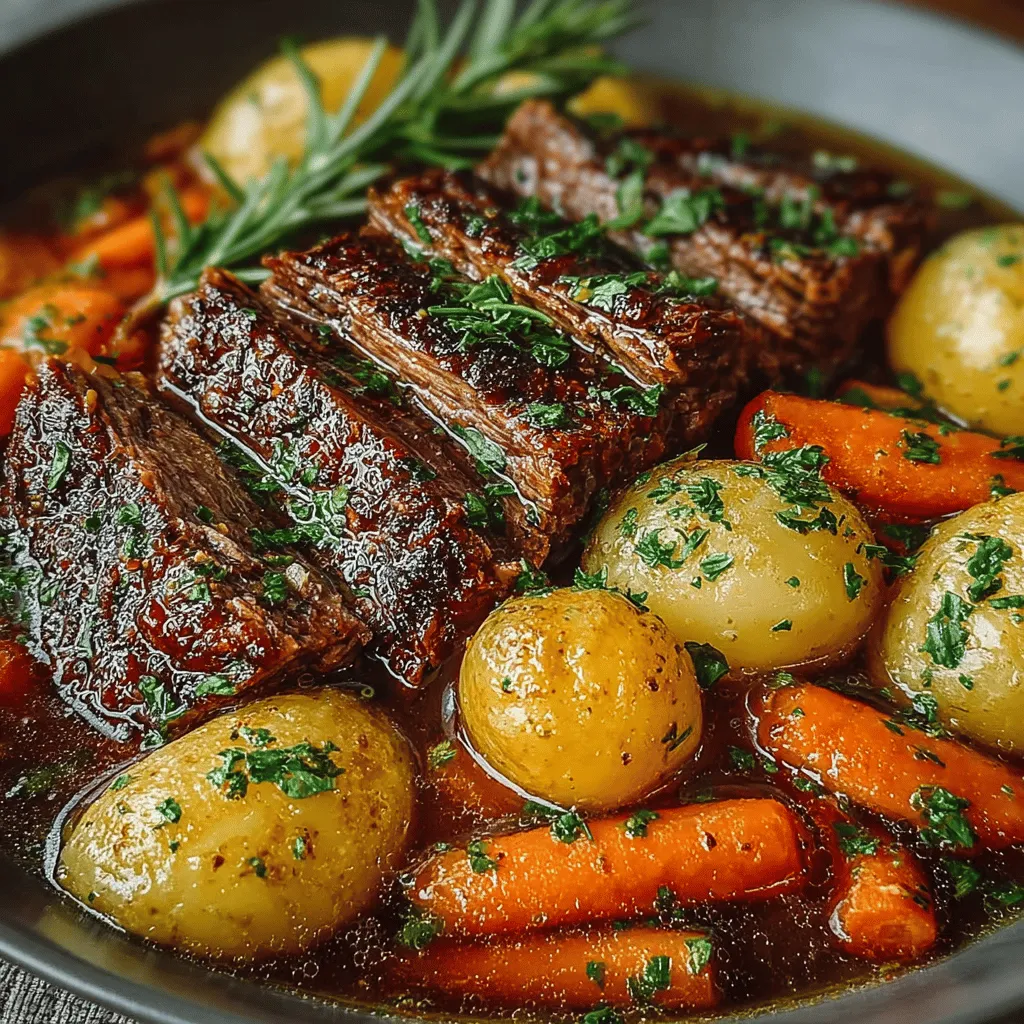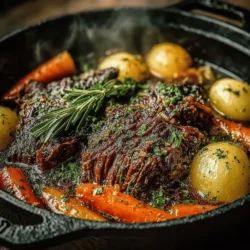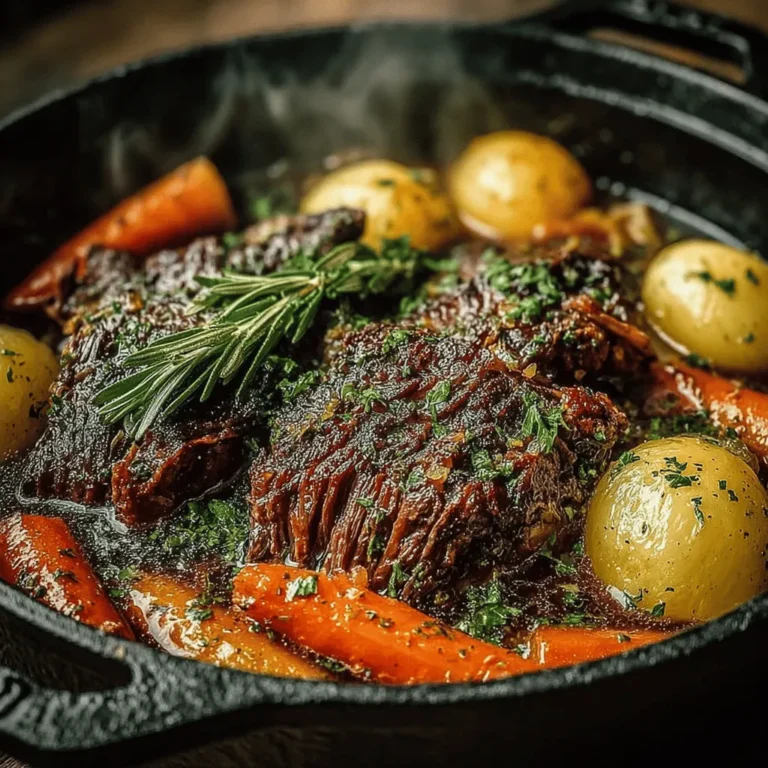Comforting Beef & Garden Vegetable Pot Roast
Introduction
When it comes to home cooking, few dishes embody the essence of comfort food quite like a pot roast. This timeless meal has been a staple in kitchens across the globe, providing a sense of warmth and satisfaction with each bite. The appeal of comfort food lies not only in its ability to nourish but also in its power to evoke cherished memories of family gatherings, chilly evenings, and the simple joy of sharing a hearty meal with loved ones.
Among the myriad of comfort food options, Beef & Garden Vegetable Pot Roast stands out as a quintessential choice. This dish marries the rich, robust flavors of tender beef with an array of vibrant garden vegetables, creating a symphony of taste and texture that is as inviting as it is delicious. Pot roast is particularly beloved during the colder months when a warm, filling meal is not just a luxury but a necessity. Its universal appeal makes it a go-to for family dinners, holiday feasts, and even casual gatherings with friends.
As we delve into this recipe, expect to uncover the secrets behind crafting a delicious, hearty meal that captures the essence of home cooking. With a few simple ingredients and some love, you can transform your kitchen into a haven of warmth and flavor.
Understanding the Ingredients
To create an unforgettable Beef & Garden Vegetable Pot Roast, it’s essential to understand the roles of each ingredient in the dish. The magic begins with the choice of beef and extends to the accompanying vegetables and herbs that enhance the overall flavor profile.
The Importance of Beef Chuck Roast
At the heart of any pot roast is the beef, and for this recipe, the beef chuck roast is the star of the show. This cut of meat is ideal for slow cooking due to its marbling, which keeps it juicy and tender as it braises. The connective tissues in chuck roast break down during the cooking process, resulting in a rich flavor that simply melts in your mouth. When selecting your beef, look for a cut that has a good amount of marbling and a deep red color, indicating freshness and quality.
The Role of Aromatics
Enhancing the flavor of the pot roast is the crucial step of incorporating aromatics. Onions and garlic are the backbone of many savory dishes, and they play a vital role in this recipe as well. Sautéing these aromatics before adding the beef not only builds a flavor base but also creates a fragrant environment that sets the stage for the dish’s development. The sweetness of caramelized onions combined with the pungent notes of garlic infuse the meat and vegetables with depth and complexity.
Nutritional Benefits of Vegetables
A pot roast wouldn’t be complete without its supporting cast of vegetables. Carrots, potatoes, and celery are classic additions that not only add flavor but also nutritional value. Carrots bring a natural sweetness and are packed with vitamins and antioxidants, while potatoes provide heartiness and comfort in every bite. Celery, with its crisp texture and subtle flavor, rounds out the dish and adds a refreshing crunch. Together, these vegetables create a balanced meal that nourishes both body and soul.
Seasoning Essentials
No pot roast would be complete without the right seasonings to elevate its flavors. Fresh herbs like thyme and rosemary add an aromatic quality that complements the beef and vegetables beautifully. Thyme, with its earthy notes, pairs perfectly with the richness of the meat, while rosemary adds a hint of pine that brightens the dish. Additionally, bay leaves contribute a subtle depth of flavor. Together, these herbs create a fragrant bouquet that enhances the overall enjoyment of the meal.
The Option of Red Wine
For those looking to deepen the flavor and add a layer of richness, incorporating red wine into the pot roast is an excellent option. The acidity in wine helps to tenderize the meat while infusing it with complex flavors. A good-quality dry red wine, such as Cabernet Sauvignon or Merlot, can take your pot roast to the next level, creating a dish that is not only comforting but also sophisticated.
Preparation of the Beef & Vegetables
Now that you understand the key components of your Beef & Garden Vegetable Pot Roast, it’s time to dive into the preparation process. The initial steps are crucial for setting the foundation of flavor and ensuring that your pot roast turns out perfectly every time.
Preparing the Beef
Before you even think about cooking, it’s essential to prepare your beef properly. Start by removing the chuck roast from its packaging and patting it dry with paper towels. This step is key: a dry surface allows for better searing, which is critical for developing flavor. Once dried, season the beef generously with salt and pepper. This seasoning will penetrate the meat, enhancing its natural flavors as it cooks.
Searing the Meat
The next step is searing the meat, and this is where the Maillard reaction comes into play. This complex chemical reaction occurs when proteins and sugars in the meat are exposed to high heat, resulting in a beautifully browned crust that is packed with flavor. To achieve this, heat a heavy-bottomed pot or Dutch oven over medium-high heat, adding a splash of oil once it’s hot. Carefully place the seasoned chuck roast in the pot, allowing it to sear undisturbed for several minutes until a deep brown crust forms. This step is crucial, as it not only enhances the taste but also creates fond—those delicious browned bits stuck to the bottom of the pot—which will later contribute to the sauce.
Once the roast is seared on all sides, remove it from the pot and set it aside. This will allow you to build layers of flavor with the next steps in your pot roast preparation.
By following these initial steps, you’re well on your way to creating a comforting Beef & Garden Vegetable Pot Roast that will warm your heart and satisfy your hunger. Stay tuned for the next part of this recipe, where we will explore the assembly and cooking process that brings this beloved dish to life.

Sautéing Aromatics: Techniques for Achieving the Perfect Onion and Garlic Sauté
Sautéing your aromatics is a crucial step that sets the foundation for your pot roast’s flavor. Begin by heating a generous amount of olive oil or unsalted butter in your heavy-bottomed pot over medium heat. The oil should shimmer but not smoke, which indicates it’s ready for the next step.
Once the oil is heated, add your diced onions. Stir occasionally, allowing them to soften and become translucent, about 5-7 minutes. The goal here is to coax out the natural sweetness of the onions, enhancing the overall flavor profile of the dish. After the onions have softened, add minced garlic and sauté for another 1-2 minutes. The garlic should become fragrant but be careful not to let it brown too much, as burnt garlic can introduce bitterness to your dish.
This combination of sautéed onions and garlic will create a savory base for your pot roast, infusing the beef and vegetables with rich flavor as they cook together.
Deglazing the Pot: How to Enhance Flavors by Incorporating Fond from the Pot
After sautéing your aromatics, the next important step is deglazing the pot. This is where the magic happens! Deglazing involves adding a liquid to the hot pot to lift the flavorful browned bits (fond) that have stuck to the bottom during sautéing.
For this recipe, you can use a splash of red wine, beef broth, or even water. Add about a cup of your chosen liquid to the pot, scraping the bottom with a wooden spoon to release the fond. As the liquid bubbles, it will incorporate those rich flavors back into the dish. Allow the mixture to simmer for a couple of minutes until slightly reduced. This step not only enhances the taste of your pot roast but also adds depth and complexity to the overall dish.
Combining and Cooking the Pot Roast
Detailed Instructions on How to Combine Ingredients Effectively
Once your aromatics are sautéed and the pot is deglazed, it’s time to combine the ingredients for your pot roast. Begin by returning your seared beef to the pot, ensuring it is nestled among the onions and garlic. Next, add your choice of root vegetables, such as carrots, potatoes, and parsnips, cut into uniform pieces to ensure even cooking.
For an added layer of flavor, sprinkle in your herbs. Fresh thyme and bay leaves work wonderfully with this dish. If you prefer a more robust flavor, consider adding a sprig of rosemary as well.
Importance of Liquid: Discussing the Beef Broth and Its Role in Cooking
Now, it’s essential to consider the amount of liquid you will need. Pour in enough beef broth to cover about two-thirds of the meat and vegetables. This will ensure that everything cooks evenly while keeping some of the beef exposed to develop a nice crust.
The beef broth not only provides moisture but also adds rich, savory flavor as it reduces and concentrates during the cooking process. If you want to enhance the umami profile of your roast, consider adding a tablespoon of Worcestershire sauce or soy sauce at this stage.
Layering Flavors: How to Strategically Add Vegetables and Herbs
Layering flavors is essential for creating a rich and satisfying pot roast. Start by adding hearty vegetables first, such as potatoes and carrots, which take longer to cook. These should be placed at the bottom of the pot, where they will absorb the flavors as they simmer.
Next, place your beef on top of these vegetables, allowing it to be surrounded by flavor without being submerged entirely. Finally, add any delicate vegetables, such as green beans, about halfway through the cooking time to prevent them from becoming mushy.
Cooking Methods: Comparing Stovetop Simmering to Oven Roasting
You have two options for cooking your pot roast: stovetop simmering or oven roasting.
– Stovetop Simmering: If you choose to simmer on the stovetop, cover the pot and reduce the heat to low. Let it cook gently for about 3-4 hours, checking occasionally to ensure it does not boil. This method allows for direct control of the cooking temperature and is excellent for a cozy stovetop experience.
– Oven Roasting: Alternatively, you can transfer your pot to a preheated oven at 300°F (150°C). This method provides a more even heat distribution and can enhance the browning of the meat. Roast for approximately 3-4 hours, or until the beef is fork-tender and the vegetables are soft.
Both methods create a deliciously tender pot roast, so choose whichever fits your cooking style best!
Serving Suggestions and Pairings
Presentation Tips for a Beautiful Serving
When the pot roast is fully cooked, the aroma will be irresistible! To serve, carefully remove the beef from the pot and let it rest for about 10-15 minutes. This resting time allows the juices to redistribute, ensuring each slice is juicy and flavorful.
Slice the beef against the grain to maximize tenderness. Arrange the slices on a large serving platter, surrounded by the colorful array of vegetables. Drizzle some of the cooking liquid over the top for added flavor and moisture. Garnish with freshly chopped parsley for a pop of color and freshness.
Suggested Accompaniments
Crusty Bread: Why It Complements the Dish
No pot roast is complete without a side of crusty bread! A rustic loaf pairs perfectly, allowing you to soak up the delicious gravy. Whether you choose a sourdough, baguette, or a hearty multigrain, having bread on the table elevates the meal to new heights.
Creamy Mashed Potatoes: The Classic Pairing and How to Make Them
While the pot roast is filling, creamy mashed potatoes are a classic accompaniment that never disappoints. To make them, boil peeled and cubed potatoes until fork-tender, then drain and return them to the pot. Add warm milk, butter, salt, and pepper to taste, mashing until smooth. For an extra touch, consider folding in sour cream or cream cheese for a richer flavor.
Garnishing: The Role of Fresh Parsley in Enhancing Presentation and Flavor
Fresh parsley not only brightens up the presentation of your pot roast but also adds a layer of flavor. Sprinkle chopped parsley over the dish just before serving to enhance the visual appeal and provide a fresh taste that balances the richness of the roast.
Conclusion
The Comforting Beef & Garden Vegetable Pot Roast is more than just a meal; it is a heartwarming experience that brings people together. This dish encapsulates the essence of home cooking, filled with the rich, savory flavors that evoke nostalgia and togetherness.
As you gather around the table with family and friends, sharing this pot roast creates lasting memories—whether it’s a chilly evening or a festive gathering. The joy of cooking and sharing meals is a tradition worth celebrating, and this pot roast recipe is a perfect way to do just that.
We encourage you to try this recipe, experiment with your favorite vegetables, and enjoy the process of creating something delicious. In a world that often moves too fast, taking the time to prepare and share a home-cooked meal can strengthen bonds and foster connections that truly matter. Embrace the significance of traditional recipes like this one, as they not only nourish the body but also feed the soul. Happy cooking!


